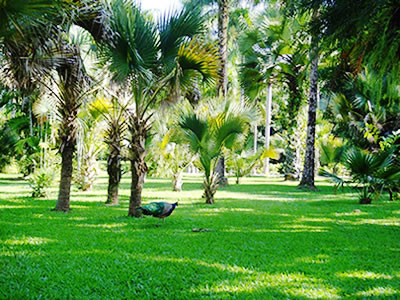版纳植物园利用物种分布模型评估未来气候会怎样影响云南木本
中科院西双版纳热带植物园综合保护中心植物地理组利用物种分布模型,揭示未来气候变化对云南木本植物分布区的影响。相关文章发表于2013年12月17日的《Diversity and Distributions》杂志上。

版纳植物园利用物种分布模型评估未来气候会怎样影响云南木本植物分布
由温室气体排放等原因引起的气候变化已经开始作用于植物的分布格局。探究气候变化如何作用于植物区域分布格局是制定前瞻性生物多样性保护策略的一个重要议题,这些前瞻性策略能减轻未来气候变化对生物多样性的影响。
中科院西双版纳热带植物园综合保护中心植物地理组博士张明罡在导师J. W. Ferry Slik研究员和周浙昆研究员的指导下,基于政府间气候变化专门委员会(IPCC)的第四次报告,利用物种分布模型评估了2080年九种气候变化情境下物种的分布格局(三种大气环流模型:CGCM、CSIRO和HADCM3,每种模型有三种温室气体排放情境:A1b、A2a和B2a),每种情境分为无迁移和无限制迁移两种假设。
结果表明,在气候变化条件下,物种沿纬度的迁移有着极其微弱的作用,沿海拔梯度的迁移发挥着重要的作用。这就意味着在云南省长距离的生态廊道发挥的作用是比较微弱的,应该重点关注物种沿海拔梯度的迁移。
当前的物种丰富度是由降水和温度的稳定性决定的,通过计算空间单元之间的移入种、移出种、恒有种的数量和比例,研究发现将来引起物种本地灭绝的主要原因是干季降水的减少和气温波动幅度的增大。这些结果在未来进行战略性森林恢复的时候应该被考虑在内。
原文摘要:
Major declines of woody plant species ranges under climate change in Yunnan, China
Ming-Gang Zhang, Zhe-Kun Zhou, Wen-Yun Chen, Charles H. Cannon, Niels Raes,J. W. Ferry Slik
Aim
A wide range of forests distributed across steep environmental grADIents are found in Yunnan, southwest China. Climate change could profoundly change these forests by affecting species ranges. We produce predictions about species suitable habitat shifts and use these to (1) evaluate species range size change, loss and turn-over under no- and full-dispersal and nine climate change scenarios and (2) identify environmental variables responsible for current species richness and future local species losses.
Location
Yunnan Province, Southwest China.
Methods
Using MaxEnt, we modelled current distributions of 2319 woody plant species, corrected for collecting bias and found that 1996 had significant spatial association with environmental factors. Using three General Circulation Models (GCMs: CGCM, CSIRO and HADCM3) for the years 2070–2099 (2080s), based on three emission scenarios for each GCM (A1b, A2a and B2a), we predicted the future geographic position of suitable habitat for each species.
Results
Although most species were predicted to persist within Yunnan, with a maximum extinction rate of c. 6% under the most extreme climate change scenario, up to 1400 species (of the 1996 tested) are expected to lose more than 30% of their current range under the most extreme climate change scenario. Assuming no- or unlimited dispersal minimally affected these outcomes. Species losses were associated with increasing temperature variABIlity and declining precipitation during the dry season.
Main conclusions
To conserve Yunnan's woody flora, management efforts should focus on providing elevational migration routes at local scales, with priority for those areas located within previously identified conservation hotspots. As almost all species show range contractions, storage of genetic diversity in seed banks and botanical gardens would be sensible. A change in Yunnan's conservation policy will be needed to counter the predicted negative impacts of climate change on its flora.

